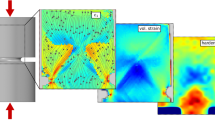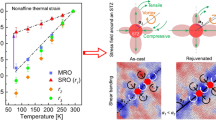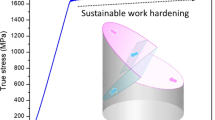Abstract
Strain-hardening (the increase of flow stress with plastic strain) is the most important phenomenon in the mechanical behaviour of engineering alloys because it ensures that flow is delocalized, enhances tensile ductility and inhibits catastrophic mechanical failure1,2. Metallic glasses (MGs) lack the crystallinity of conventional engineering alloys, and some of their properties—such as higher yield stress and elastic strain limit3—are greatly improved relative to their crystalline counterparts. MGs can have high fracture toughness and have the highest known ‘damage tolerance’ (defined as the product of yield stress and fracture toughness)4 among all structural materials. However, the use of MGs in structural applications is largely limited by the fact that they show strain-softening instead of strain-hardening; this leads to extreme localization of plastic flow in shear bands, and is associated with early catastrophic failure in tension. Although rejuvenation of an MG (raising its energy to values that are typical of glass formation at a higher cooling rate) lowers its yield stress, which might enable strain-hardening5, it is unclear whether sufficient rejuvenation can be achieved in bulk samples while retaining their glassy structure. Here we show that plastic deformation under triaxial compression at room temperature can rejuvenate bulk MG samples sufficiently to enable strain-hardening through a mechanism that has not been previously observed in the metallic state. This transformed behaviour suppresses shear-banding in bulk samples in normal uniaxial (tensile or compressive) tests, prevents catastrophic failure and leads to higher ultimate flow stress. The rejuvenated MGs are stable at room temperature and show exceptionally efficient strain-hardening, greatly increasing their potential use in structural applications.
This is a preview of subscription content, access via your institution
Access options
Access Nature and 54 other Nature Portfolio journals
Get Nature+, our best-value online-access subscription
$29.99 / 30 days
cancel any time
Subscribe to this journal
Receive 51 print issues and online access
$199.00 per year
only $3.90 per issue
Buy this article
- Purchase on Springer Link
- Instant access to full article PDF
Prices may be subject to local taxes which are calculated during checkout




Similar content being viewed by others
Data availability
All data generated or analysed during this study are included in the published article and the Extended Data, and are available from the corresponding authors upon reasonable request.
References
Cottrell, A. H. The Mechanical Properties of Matter (Krieger, 1981).
Dieter, G. E. Mechanical Metallurgy (McGraw-Hill, 1961).
Ashby, M. F. & Greer, A. L. Metallic glasses as structural materials. Scr. Mater. 54, 321–326 (2006).
Demetriou, M. D. et al. A damage-tolerant glass. Nat. Mater. 10, 123–128 (2011).
Sun, Y. H., Concustell, A. & Greer, A. L. Thermomechanical processing of metallic glasses: extending the range of the glassy state. Nat. Rev. Mater. 1, 16039 (2016).
Taylor, G. I. The mechanism of plastic deformation of crystals. Part I.−Theoretical. Proc. R. Soc. Lond. A 145, 362–387 (1934).
Spaepen, F. A microscopic mechanism for steady state inhomogeneous flow in metallic glasses. Acta Metall. 25, 407–415 (1977).
Greer, A. L., Cheng, Y. Q. & Ma, E. Shear bands in metallic glasses. Mater. Sci. Eng. Rep. 74, 71–132 (2013).
Volkert, C. A., Donohue, A. & Spaepen, F. Effect of sample size on deformation in amorphous metals. J. Appl. Phys. 103, 083539 (2008).
Jang, D. & Greer, J. R. Transition from a strong-yet-brittle to a stronger-and-ductile state by size reduction of metallic glasses. Nat. Mater. 9, 215–219 (2010).
Wang, Z. T., Pan, J., Li, Y. & Schuh, C. A. Densification and strain hardening of a metallic glass under tension at room temperature. Phys. Rev. Lett. 111, 135504 (2013).
Ketkaew, J. et al. Mechanical glass transition revealed by the fracture toughness of metallic glasses. Nat. Commun. 9, 3271 (2018).
Pan, J. et al. Extreme rejuvenation and softening in a bulk metallic glass. Nat. Commun. 9, 560 (2018).
Ma, D., Stoica, A. D. & Wang, X.-L. Power-law scaling and fractal nature of medium-range order in metallic glasses. Nat. Mater. 8, 30–34 (2009).
Wang, W. H. et al. Stability of ZrTiCuNiBe bulk metallic glass upon isothermal annealing near the glass transition temperature. J. Mater. Res. 17, 1385–1389 (2002).
Guo, W., Saida, J., Zhao, M., Lü, S. & Wu, S. Thermal rejuvenation of an Mg-based metallic glass. Metall. Mater. Trans. A 50, 1125–1129 (2019).
Pan, S. P., Qin, J. Y., Wang, W. M. & Gu, T. K. Origin of splitting of the second peak in the pair-distribution function for metallic glasses. Phys. Rev. B 84, 092201 (2011).
Januchta, K. et al. Breaking the limit of micro-ductility in oxide glasses. Adv. Sci. 6, 1901281 (2019).
Pan, J., Zhou, H. F., Wang, Z. T., Li, Y. & Gao, H. J. Origin of anomalous inverse notch effect in bulk metallic glasses. J. Mech. Phys. Solids 84, 85–94 (2015).
Pan, J., Wang, Y. X. & Li, Y. Ductile fracture in notched bulk metallic glasses. Acta Mater. 136, 126–133 (2017).
Shanmugam, J., Borisenko, K. B., Chou, Y.-J. & Kirkland, A. I. eRDF Analyser: an interactive GUI for electron reduced density function analysis. SoftwareX 6, 185–192 (2017).
Guo, H. et al. Tensile ductility and necking of metallic glass. Nat. Mater. 6, 735–739 (2007).
Tian, L. et al. Approaching the ideal elastic limit of metallic glasses. Nat. Commun. 3, 609 (2012).
Tian, L., Shan, Z. W. & Ma, E. Ductile necking behavior of nanoscale metallic glasses under uniaxial tension at room temperature. Acta Mater. 61, 4823–4830 (2013).
Chen, D. Z., Gu, X. W., An, Q., Goddard, W. A., III & Greer, J. R. Ductility and work hardening in nano-sized metallic glasses. Appl. Phys. Lett. 106, 061903 (2015).
Qu, R. T., Liu, Z. Q., Wang, G. & Zhang, Z. F. Progressive shear band propagation in metallic glasses under compression. Acta Mater. 91, 19–33 (2015).
Wang, J. G. et al. Hardening of shear band in metallic glass. Sci. Rep. 7, 7076 (2017).
Joo, S.-H. et al. Work-hardening induced tensile ductility of bulk metallic glasses via high-pressure torsion. Sci. Rep. 5, 9660 (2015).
Das, J. et al. “Work-hardenable” ductile bulk metallic glass. Phys. Rev. Lett. 94, 205501 (2005).
Yao, K. F. & Zhang, C. Q. Fe-based bulk metallic glass with high plasticity. Appl. Phys. Lett. 90, 061901 (2007).
Xie, S., Tu, X. & Kruzic, J. J. Inducing strain hardening in a Zr-based bulk metallic glass via cobalt mediated phase separations. J. Alloys Compd. 735, 1576–1581 (2018).
Wang, T. et al. Two-step work-hardening and its gigantic toughening effect in Zr-based bulk metallic glasses. Scr. Mater. 150, 106–109 (2018).
Rashidi, R., Malekan, M. & Gholamipour, R. Microstructure and mechanical properties of a Cu-Zr based bulk metallic glass containing atomic scale chemical heterogeneities. Mater. Sci. Eng. A 729, 433–438 (2018).
Wu, Y., Xiao, Y., Chen, G., Liu, C. T. & Lu, Z. Bulk metallic glass composites with transformation-mediated work-hardening and ductility. Adv. Mater. 22, 2770–2773 (2010).
Hofmann, D. C. Shape memory bulk metallic glass composites. Science 329, 1294–1295 (2010).
Pauly, S., Gorantla, S., Wang, G., Kühn, U. & Eckert, J. Transformation-mediated ductility in CuZr-based bulk metallic glasses. Nat. Mater. 9, 473–477 (2010).
Kim, C. P., Oh, Y. S., Lee, S. & Kim, N. J. Realization of high tensile ductility in a bulk metallic glass composite by the utilization of deformation-induced martensitic transformation. Scr. Mater. 65, 304–307 (2011).
Song, K. K. et al. Triple yielding and deformation mechanisms in metastable Cu47.5Zr47.5Al5 composites. Acta Mater. 60, 6000–6012 (2012).
He, Q., Shang, J. K., Ma, E. & Xu, J. Crack-resistance curve of a Zr-Ti-Cu-Al bulk metallic glass with extraordinary fracture toughness. Acta Mater. 60, 4940–4949 (2012).
Zhang, Z. F., Eckert, J. & Schultz, L. Difference in compressive and tensile fracture mechanisms of Zr59Cu20Al10Ni8Ti3 bulk metallic glass. Acta Mater. 51, 1167–1179 (2003).
Bennett, C. H. Serially deposited amorphous aggregates of hard spheres. J. Appl. Phys. 43, 2727–2734 (1972).
Kelton, K. F. et al. First X-ray scattering studies on electrostatically levitated metallic liquids: demonstrated influence of local icosahedral order on the nucleation barrier. Phys. Rev. Lett. 90, 195504 (2003).
Boyer, H. E. (ed.) Atlas of Stress–Strain Curves (ASM International, 2002).
Acknowledgements
Y.L. and J.P. acknowledge support from National Natural Science Foundation of China under grant number 51871217 and from the Shenyang National Laboratory for Materials Science. A.L.G. and Yu.P.I. acknowledge support from the European Research Council under the European Union’s Horizon 2020 Research and Innovation programme (grant ERC-2015-AdG-695487: ExtendGlass). We thank A. Chuvilin for technical support of HRTEM (CIC, NanoGUNE, Spain), and J. Zhang for technical support and W. Huang for casting the rod samples (IMR, Shenyang, China).
Author information
Authors and Affiliations
Contributions
Y.L. and A.L.G. led the project and the writing of the paper. Rejuvenation of the MG samples and their characterization by microhardness testing, differential scanning calorimetry, uniaxial mechanical loading and surface observation by scanning electron microscopy were carried out by J.P. and W.H.Z. Transmission electron microscopy, including high-resolution TEM and the calculation of radial distribution functions, was performed by Yu.P.I. All authors contributed to the interpretation and presentation of the results.
Corresponding authors
Ethics declarations
Competing interests
The authors declare no competing interests.
Additional information
Peer review information Nature thanks Jan Schroers and the other, anonymous, reviewer(s) for their contribution to the peer review of this work.
Publisher’s note Springer Nature remains neutral with regard to jurisdictional claims in published maps and institutional affiliations.
Extended data figures and tables
Extended Data Fig. 1 Uniaxial compression of Zr61Cu25Al12Ti2 MG rods (1.5-mm diameter, 3.0-mm height).
a, Engineering stress–strain curves of as-cast and rejuvenated rods. On increasing the stress, the yield stress σy is the point at which there is the first deviation from linearity. The curve of the rejuvenated rods shows a more gradual onset of yielding and a lower σy. b, Superposed stress–strain curves for different rejuvenated rods. The compression tests were terminated at different points, and the total strain εt (1.8–20%) and flow stress σf (1.51–2.41 GPa) are listed in the key. The close correspondence of the curves shows the reproducibility of the results, and the increase in σf is evidence for strain-hardening. In addition, the possibility of large strain without fracture and the very low amplitude of serrations (compared to an as-cast sample; see the inset in Fig. 1b) are clear.
Extended Data Fig. 2 Onset of inhomogeneous flow (shear-banding) in the compression of Zr61Cu25Al12Ti2 MG rods.
Scanning electron microscopy images of the samples used in the tests shown in Extended Data Fig. 1b, labelled with the corresponding values of total strain (εt). a, Shear-banding associated with the onset of plastic flow in the as-cast glass. b, Close-up image of the shear bands shown in a. c–h, Rods of rejuvenated MG (insets), tested to the total strains shown, and close-up images of the surfaces (main images). The onset of shear-banding is at εt = 2.8–3.7%. For finely spaced shear bands, extensive, relatively uniform flow and bulging of the sample can be seen (h).
Extended Data Fig. 3 Tensile testing of rejuvenated Zr64.13Cu15.75Ni10.12Al10 MG.
a, The test sample is shown in the inset. The stress–strain curves obtained on reloading are offset for clarity. On the second loading (green curve), yielding (indicated by the arrow) begins at σy = 1.27 GPa and εy = 1.7%, and continues to εp = 0.26% and εt = 2.35%; at that point σf = 1.52 GPa, which is the yield stress at which flow resumes on the third loading, showing clear strain-hardening. On the third loading, serrations begin at εp = 0.31% and εt = 2.73%, and ultimate failure is at εp = 0.42%, εt = 2.84% and σf = 1.61 GPa. b, c, Shear-banding is observed only near the fracture. It is clear that shear-banding can be suppressed for small εp and that this suppression is important because the onset of shear-banding appears to be quickly followed by fracture. d, Fracture occurs by shear in the through-thickness direction on a plane inclined at 54° to the tensile axis. This angle is typical for MG failure in tension40. e, Differential scanning calorimetry (DSC) traces measured on heating MG samples at 20 K min−1: as-cast (blue), rejuvenated (red), and rejuvenated and then deformed to fracture in uniaxial tension (green). The dashed horizontal lines in the inset show the baseline with respect to which the heat of relaxation ΔHrel is measured. Details about the samples are provided in Extended Data Table 3. The dashed box in the inset shows the portion of the fractured sample used for the DSC measurement of the rejuvenated and deformed MG, and the arrow points to the corresponding DSC trace. In agreement with the results of compression tests (Figs. 1b, 3), the strain-hardening in tension can also be associated with structural relaxation: the heat of relaxation in the rejuvenated MG, 1.25 kJ mol−1, is reduced to 0.64 kJ mol−1 in the sample loaded in tension to fracture. Exo., exothermic; Rej., rejuvenated sample; Rej. + Tension, rejuvenated and deformed sample.
Extended Data Fig. 4 TEM of the central region of a rejuvenated Zr64.13Cu15.75Ni10.12Al10 MG sample.
The high-angle annular dark-field (HAADF) image and the EDX maps show the sample to be structurally and chemically homogeneous. The measured elemental contents are close to the nominal values. at.%, atomic percentage.
Extended Data Fig. 5 Radial distribution function analysis of as-cast and rejuvenated samples of Zr64.13Cu15.75Ni10.12Al10 MG.
The radial distribution functions (RDF) are computed from SAED patterns acquired by TEM. The RDF represents the local density of atoms at a distance r from a central atom. The samples are taken from the regions indicated in Fig. 4b (inset). The as-cast sample is taken from a region far from that affected by the rejuvenation treatment. In samples from rejuvenated regions, the nearest-neighbour (r1) peak is at a higher r value than the as-cast sample. Because no change in chemical homogeneity is observed, this shift is taken to indicate a reduction in density of the MG, as also inferred from the first peak in I(q) (Fig. 4b). The second peak (r2) shows the splitting (shoulder at high r) that is characteristic of MGs41,42. This characteristic shape appears on cooling the liquid through the glass transition, and can be taken to indicate the nature of the linking between the nearest-neighbour coordination shells around the atoms17, with the main peak being associated with linking through shared edges. On rejuvenation, the shoulder at high r grows, indicating more linking through vertices, and the shoulder at low r shrinks, indicating less linking through shared faces. All these changes are consistent with rejuvenation resulting in more loosely packed or liquid-like regions. The labels ×3, ×5 and ×10 indicate the magnification factors applied to the intensities of the corresponding peaks in the RDF curves to facilitate visualization and comparison.
Extended Data Fig. 6 True stress–true strain curves comparing strain-hardening in rejuvenated Zr64.13Cu15.75Ni10.12Al10 MG and in a conventional engineering alloy (316 stainless steel, annealed).
The behaviour of crystalline metals and alloys is often characterized by fitting the plastic-flow part of the curve to σf = Kεn, where ε is the strain, K is the flow stress at ε = 1.0, and the strain-hardening exponent n is typically 0.1–0.3. Considering the full range of the curve in each case, the elastic limit (circled) occurs at much higher relative stress and strain for the MG than for the conventional alloy, and n is inappropriate for characterizing the MG. Instead we use the initial rate of hardening, R = d(true stress)/d(true strain), indicated by the arrows. The MG has much higher values of R and of R/σy—so high that, except in close-up (for example, Fig. 1b inset), the transition from elastic to plastic deformation is difficult to discern—and a much smaller total increase in flow stress σf relative to σy. The high value of R/σy leads to rapid saturation of the hardening, after which the MG reverts to the strain-softening behaviour of as-cast unrejuvenated glasses. Notably, however, the rejuvenated and then hardened glass continues to have much more uniform flow (smaller stress serrations) than an as-cast glass. The curve for the stainless steel is based on published data43, and can be taken as an intermediate case for engineering alloys: the value of R/σy and the strain to failure is higher for pure metals and lower for hardened alloys. The curve for the MG measured in this work was obtained on continuous loading under compression.
Rights and permissions
About this article
Cite this article
Pan, J., Ivanov, Y.P., Zhou, W.H. et al. Strain-hardening and suppression of shear-banding in rejuvenated bulk metallic glass. Nature 578, 559–562 (2020). https://doi.org/10.1038/s41586-020-2016-3
Received:
Accepted:
Published:
Issue Date:
DOI: https://doi.org/10.1038/s41586-020-2016-3
This article is cited by
-
Absence of ultrasonic-vibration-induced plasticity in metallic glacial glasses
Rare Metals (2024)
-
Exceptional Thermal Stability and Properties of Amorphous High-Entropy SiNbTaTiZr Thin Films
High Entropy Alloys & Materials (2024)
-
A Study on the Correlation of Liquid Kinetic and Thermodynamic Distribution Mapping
JOM (2024)
-
Accelerating structural relaxation of shear band at ambient conditions through cryogenic thermal-cycling
Science China Materials (2024)
-
Rejuvenation engineering in metallic glasses by complementary stress and structure modulation
NPG Asia Materials (2023)
Comments
By submitting a comment you agree to abide by our Terms and Community Guidelines. If you find something abusive or that does not comply with our terms or guidelines please flag it as inappropriate.



